Groundwater Level Dynamics in Bengaluru City, India
Abstract
:1. Introduction
2. Materials and Methods
2.1. Study Area
2.2. Groundwater Monitoring
2.3. Rainfall Data
2.4. Cluster Analysis
2.5. Groundwater Analysis
2.5.1. Natural Recharge and Net Outflow
2.5.2. Changes in Groundwater Storage
3. Results and Discussion
3.1. Clustering Results
3.2. Groundwater Levels and Dynamics
3.3. Rainfall Recharge and Net Outflow
3.4. Extreme Rainfall Response
4. Conclusions and Future Improvements
Supplementary Materials
Acknowledgments
Author Contributions
Conflicts of Interest
References
- Kumar, M.D.; Shah, T. Groundwater Pollution and Contamination in India: The Emerging Challenge; IWMI-TATA Water Policy Program: Gujarat, India, 2006. [Google Scholar]
- Foster, S.; Hirata, R.; Misra, S.; Garduno, H. Urban groundwater use policy: Balancing the benefits and risks in developing nations. In GW-MATE Strategic Overview Series; World Bank: Washington, DC, USA, 2010; Volume 3. [Google Scholar]
- Eckstein, G.E.; Eckstein, Y. A hydrogeological approach to transboundary ground water resources and international law. Am. Univ. Int. Law Rev. 2003, 19, 201–258. [Google Scholar]
- Lerner, D.N. Identifying and quantifying urban recharge: A review. Hydrogeol. J. 2002, 10, 143–152. [Google Scholar] [CrossRef]
- Onodera, S.I.; Saito, M.; Sawano, M.; Hosono, T.; Taniguchi, M.; Shimada, J.; Umezawa, Y.; Lubis, R.F.; Buapeng, S.; Delinom, R. Effects of intensive urbanization on the intrusion of shallow groundwater into deep groundwater: Examples from Bangkok and Jakarta. Sci. Total Environ. 2008, 404, 401–410. [Google Scholar] [CrossRef] [PubMed]
- Hayashi, T.; Tokunaga, T.; Aichi, M.; Shimada, J.; Taniguchi, M. Effects of human activities and urbanization on groundwater environments: An example from the aquifer system of Tokyo and the surrounding area. Sci. Total Environ. 2009, 407, 3165–3172. [Google Scholar] [CrossRef] [PubMed]
- Gattinoni, P.; Scesi, L. The groundwater rise in the urban area of Milan (Italy) and its interactions with underground structures and infrastructures. Tunn. Undergr. Space Technol. 2017, 62, 103–114. [Google Scholar] [CrossRef]
- Gburek, W.; Folmar, G.; Urban, J. Field data and ground water modeling in a layered fractured aquifer. Groundwater 1999, 37, 175–184. [Google Scholar] [CrossRef]
- Kim, Y.Y.; Lee, K.K.; Sung, I. Urbanization and the groundwater budget, metropolitan Seoul area, Korea. Hydrogeol. J. 2001, 9, 401–412. [Google Scholar] [CrossRef]
- Rao, S.M.; Sekhar, M.; Rao, P.R. Impact of pit-toilet leachate on groundwater chemistry and role of vadose zone in removal of nitrate and E. coli pollutants in Kolar District, Karnataka, India. Environ. Earth Sci. 2013, 68, 927–938. [Google Scholar] [CrossRef]
- Bauer, S.; Bayer-Raich, M.; Holder, T.; Kolesar, C.; Müller, D.; Ptak, T. Quantification of groundwater contamination in an urban area using integral pumping tests. J. Contam. Hydrol. 2004, 75, 183–213. [Google Scholar] [CrossRef] [PubMed]
- Tellam, J.H.; Rivett, M.O.; Israfilov, R.G. Towards management and sustainable development of urban groundwater systems. In Urban Groundwater Management and Sustainability; Springer: Dordrecht, The Netherlands, 2006; pp. 1–9. [Google Scholar]
- Narain, S.; Pandey, P. Excreta Matters: How Urban India Is Soaking up Water, Polluting Rivers and Drowning in Its Own Waste; Centre for Science and Environment: New Delhi, India, 2012. [Google Scholar]
- Planning Commission, Government of India. 12th Five Year Plan (2012–2017); Sage Publications: Thousand Oaks, CA, USA, 2013; Volume I.
- Maréchal, J.C.; Dewandel, B.; Ahmed, S.; Galeazzi, L.; Zaidi, F.K. Combined estimation of specific yield and natural recharge in a semi-arid groundwater basin with irrigated agriculture. J. Hydrol. 2006, 329, 281–293. [Google Scholar] [CrossRef]
- Subash, Y.; Sekhar, M.; Tomer, S.K.; Sharma, A.K. A framework for assessment of climate change impacts on the groundwater system. In Sustainable Water Resources Management; LaMoreaux, J.W., Voss, C.I., Green, N., McCarley, A., Eds.; American Society of Civil Engineers (ASCE): Reston, VA, USA, 2017; Chapter 14. [Google Scholar]
- Drangert, J.O.; Cronin, A. Use and abuse of the urban groundwater resource: Implications for a new management strategy. Hydrogeol. J. 2004, 12, 94–102. [Google Scholar] [CrossRef]
- Öngen, A.; Tinmaz, E. Evaluation of groundwaterover-abstraction by industrial activities in the Trakya region, Turkey. In Urban Groundwater Management and Sustainability; Springer: Dordrecht, The Netherlands, 2006; pp. 117–127. [Google Scholar]
- Wolf, L.; Klinger, J.; Held, I.; Hötzl, H. Integrating groundwater into urban water management. Water Sci. Technol. 2006, 54, 395–403. [Google Scholar] [CrossRef] [PubMed]
- Srinivasan, V.; Gorelick, S.M.; Goulder, L. A hydrologic-economic modeling approach for analysis of urban water supply dynamics in Chennai, India. Water Resour. Res. 2010, 46. [Google Scholar] [CrossRef]
- Sekhar, M.; Shindekar, M.; Tomer, S.K.; Goswami, P. Modeling the vulnerability of an urban groundwater system due to the combined impacts of climate change and management scenarios. Earth Interact. 2013, 17, 1–25. [Google Scholar] [CrossRef]
- Sekhar, M.; Kumar, M.M. Geo-Hydrological Studies Along the Metro Rail Alignment in Bangalore; Technical Report; Department of Civil Engineering, Indian Institute of Science: Bangalore, India, 2009. [Google Scholar]
- Unnikrishnan, H.; Sen, S.; Nagendra, H. Traditional water bodies and urban resilience: A historical perspective from Bengaluru, India. In Water History; Springer: Dordrecht, The Netherlands, 2017; pp. 1–25. [Google Scholar] [CrossRef]
- Mehta, V.; Kemp-Benedict, E.; Goswami, R.; Muddu, S.; Malghan, D. Social ecology of domestic water use in Bangalore. Econ. Political Wkly. 2013, 48. Available online: http://www.epw.in/journal/2013/15/special-articles/social-ecology-domestic-water-use-bangalore.html (accessed on 21 December 2017).
- Farooqi, M. Ground Water Scenario in Major Cities of India; Central Ground Water Board of India: Faridabad, India, 2011.
- Mehta, V.K.; Goswami, R.; Kemp-Benedict, E.; Muddu, S.; Malghan, D. Metabolic urbanism and environmental justice: The water conundrum in Bangalore, India. Environ. Justice 2014, 7, 130–137. [Google Scholar] [CrossRef]
- Hegde, G.V.; Chandra, K.S. Resource availability for water supply to Bangalore city, Karnataka. Curr. Sci. 2012, 102, 1102–1104. [Google Scholar]
- Zimmerman, D.; Pavlik, C.; Ruggles, A.; Armstrong, M.P. An experimental comparison of ordinary and universal kriging and inverse distance weighting. Math. Geol. 1999, 31, 375–390. [Google Scholar] [CrossRef]
- Sun, Y.; Kang, S.; Li, F.; Zhang, L. Comparison of interpolation methods for depth to groundwater and its temporal and spatial variations in the Minqin oasis of northwest China. Environ. Modell. Softw. 2009, 24, 1163–1170. [Google Scholar] [CrossRef]
- Maréchal, J.; Galeazzi, L.; Dewandel, B. Groundwater Balance at the Watershed Scale in a Hard Rock Aquifer Using GIS. In Groundwater Dynamics in Hard Rock Aquifers; Ahmed, S., Jayakumar, R., Salih, A., Eds.; Springer: Dordrecht, The Netherlands, 2008; pp. 134–141. [Google Scholar]
- Balakrishnan, K. Heterogeneity within Indian Cities: Methods for Empirical Analysis. Ph.D. Thesis, University of California, Berkeley, CA, USA, 2016. [Google Scholar]
- Everitt, B.S.; Landau, S.; Leese, M.; Stahl, D. Hierarchical Clustering. In Cluster Analysis, 5th ed.; WILEY: London, UK, 2011; pp. 71–110. [Google Scholar]
- Healy, R.W.; Cook, P.G. Using groundwater levels to estimate recharge. Hydrogeol. J. 2002, 10, 91–109. [Google Scholar] [CrossRef]
- Groundwater Evaluation Committee. Ground Water Resources Estimation Methodology; Ministry of Water Resources, Government of India: New Delhi, India, 1997.
- Ahmed, S.; Jayakumar, R.; Salih, A. Groundwater Dynamics in Hard Rock Aquifers: Sustainable Management and Optimal Monitoring Network Design; Springer Science & Business Media: Dordrecht, The Netherlands, 2008. [Google Scholar]
- Mehta, V.K.; Sekhar, M.; Kemp-Benedict, E.; Sekhar, M.; Mehta, V.K.; Kemp-Benedict, E.; Malghan, D.; Gebbert, S.; Mehta, V.K.; Wang, D.; et al. Groundwater Impacts of water consumption patterns in Bengaluru, India. In Proceedings of the 5th Annual International groundwater Conference, Aurangabad, India, 20 December 2012. [Google Scholar]
- Kumar, D.; Ahmed, S. Seasonal behaviour of spatial variability of groundwater level in a granitic aquifer in monsoon climate. Curr. Sci. 2003, 2, 188–196. [Google Scholar]
- Zhang, J.; Felzer, B.S.; Troy, T.J. Extreme precipitation drives groundwater recharge: The Northern High Plains Aquifer, central United States, 1950–2010. Hydrol. Process. 2016, 30, 2533–2545. [Google Scholar] [CrossRef]
- Taylor, R.G.; Todd, M.C.; Kongola, L.; Maurice, L.; Nahozya, E.; Sanga, H.; MacDonald, A.M. Evidence of the dependence of groundwater resources on extreme rainfall in East Africa. Nat. Clim. Chang. 2013, 3, 374–378. [Google Scholar] [CrossRef] [Green Version]
- Thomas, B.F.; Behrangi, A.; Famiglietti, J.S. Precipitation intensity effects on groundwater recharge in the southwestern United States. Water 2016, 8, 90. [Google Scholar] [CrossRef]
- Park, E.; Parker, J. A simple model for water table fluctuations in response to precipitation. J. Hydrol. 2008, 356, 344–349. [Google Scholar] [CrossRef]
- Kumar, S. Soil Moisture Modelling, Retrieval from Microwave Remote Sensing and Assimilation in a Tropical Watershed. Ph.D. Thesis, Indian Institute of Science, Bangalore, India, 2012. [Google Scholar]
- Beven, K.; Binley, A. The future of distributed models: Model calibration and uncertainty prediction. Hydrol. Process. 1992, 6, 279–298. [Google Scholar] [CrossRef]
- Vázquez-Suñé, E.; Carrera, J.; Tubau, I.; Sánchez-Vila, X.; Soler, A. An approach to identify urban groundwater recharge. Hydrol. Earth Syst. Sci. 2010, 14, 2085–2097. [Google Scholar] [CrossRef] [Green Version]
- Hammami Abidi, J.; Farhat, B.; Ben Mammou, A.; Oueslati, N. Characterization of Recharge Mechanisms and Sources of Groundwater Salinization in Ras Jbel Coastal Aquifer (Northeast Tunisia) Using Hydrogeochemical Tools, Environmental Isotopes, GIS, and Statistics. J. Chem. 2017, 2017, 8610894. [Google Scholar] [CrossRef]

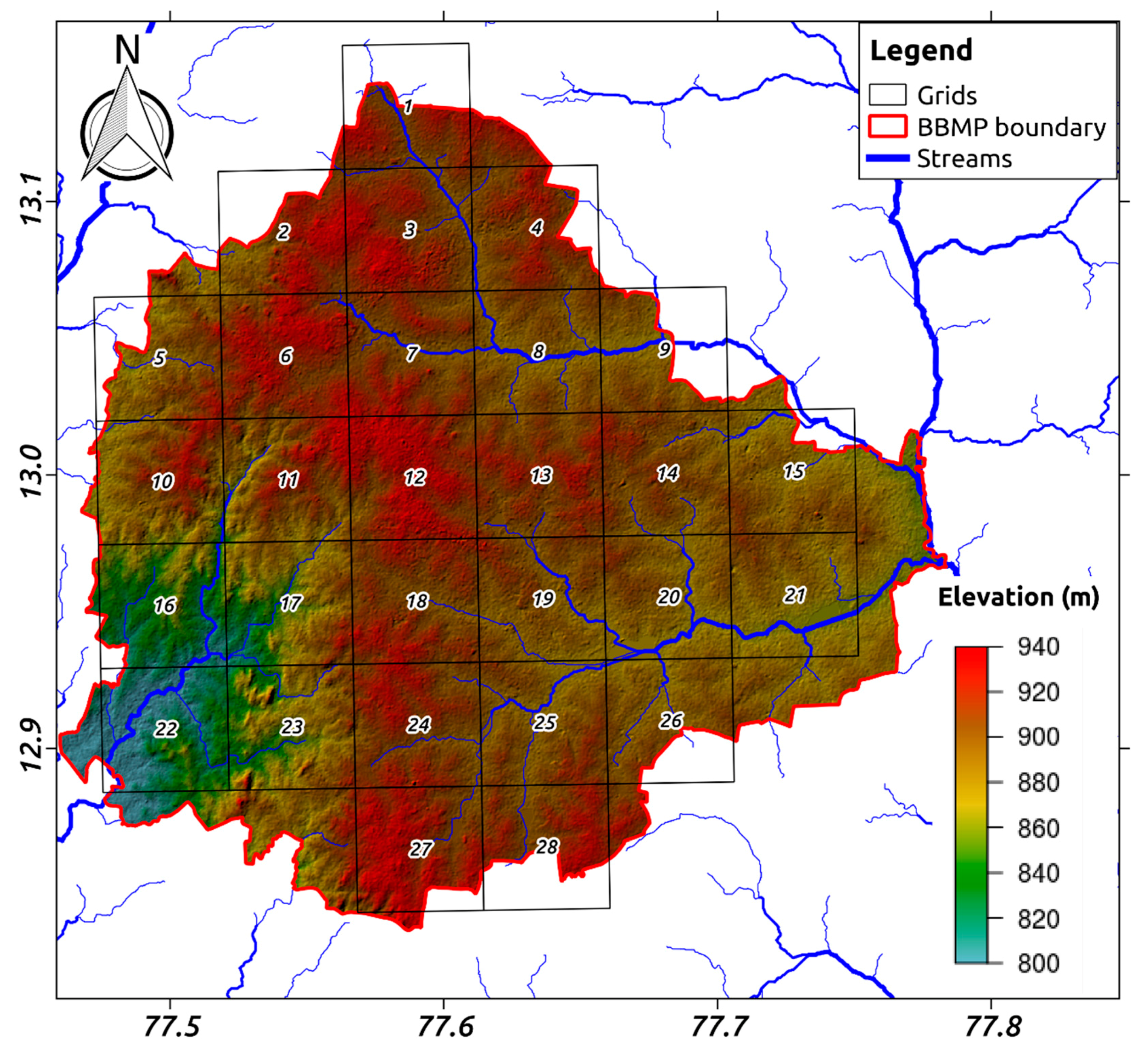
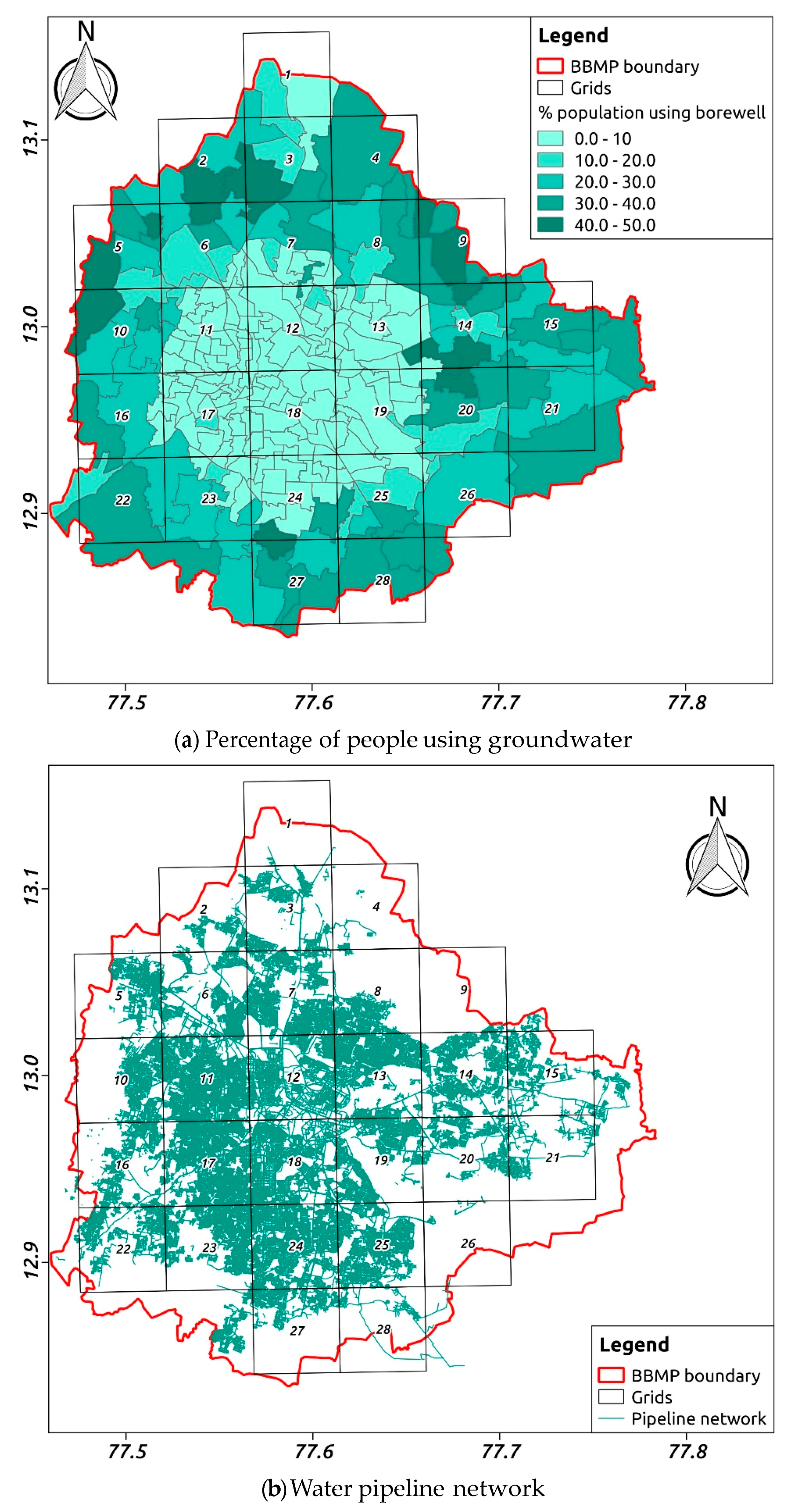
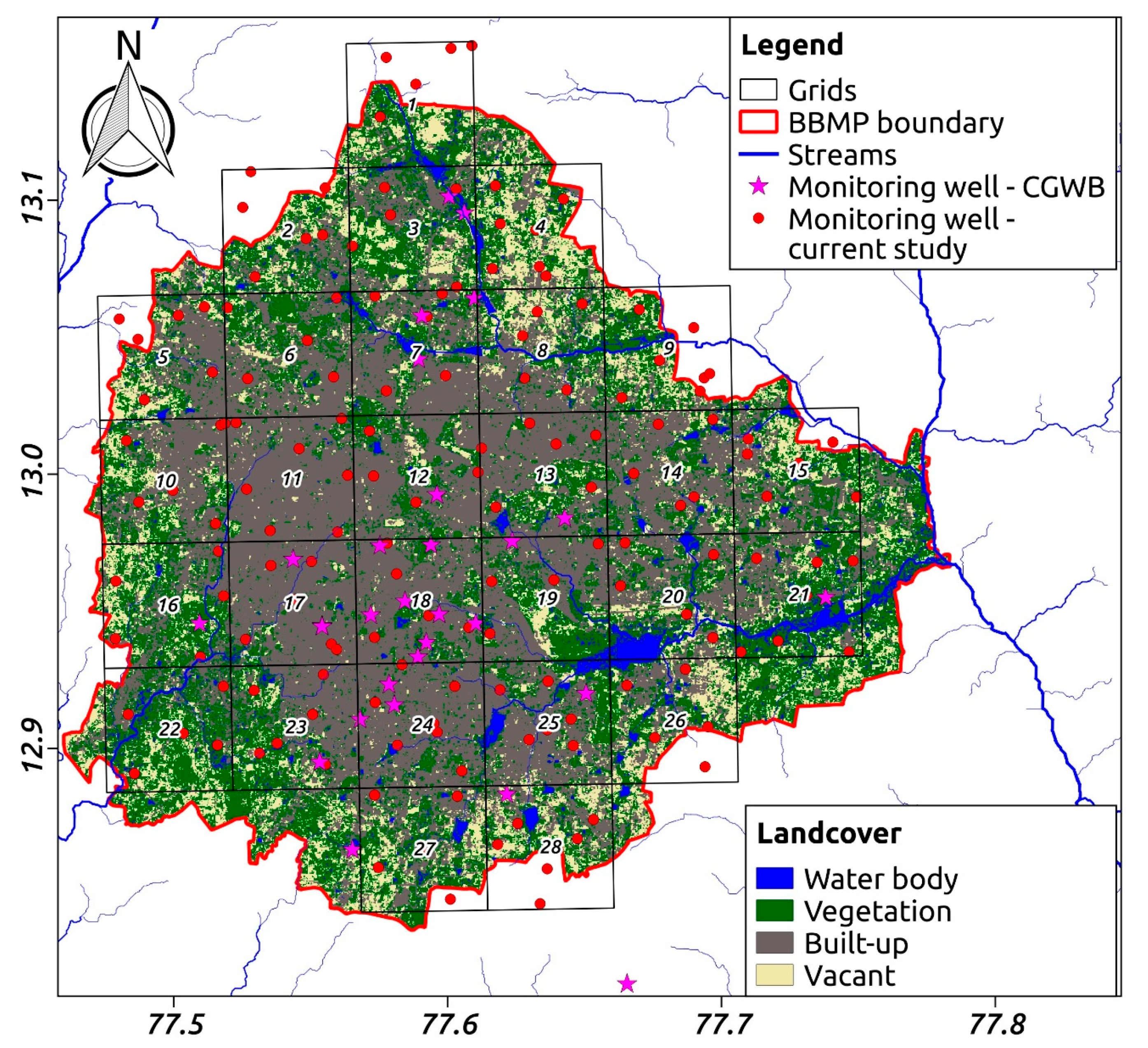
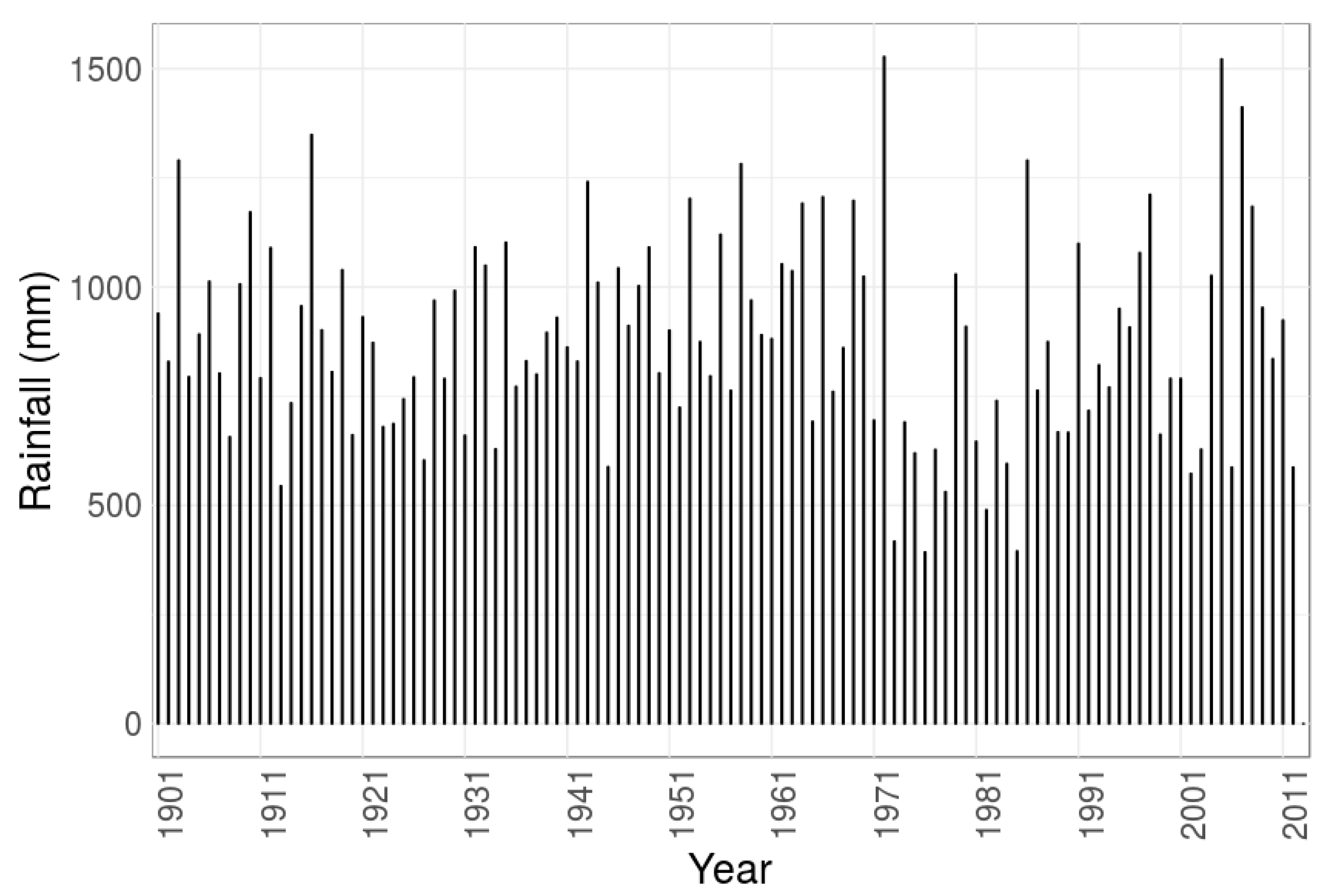
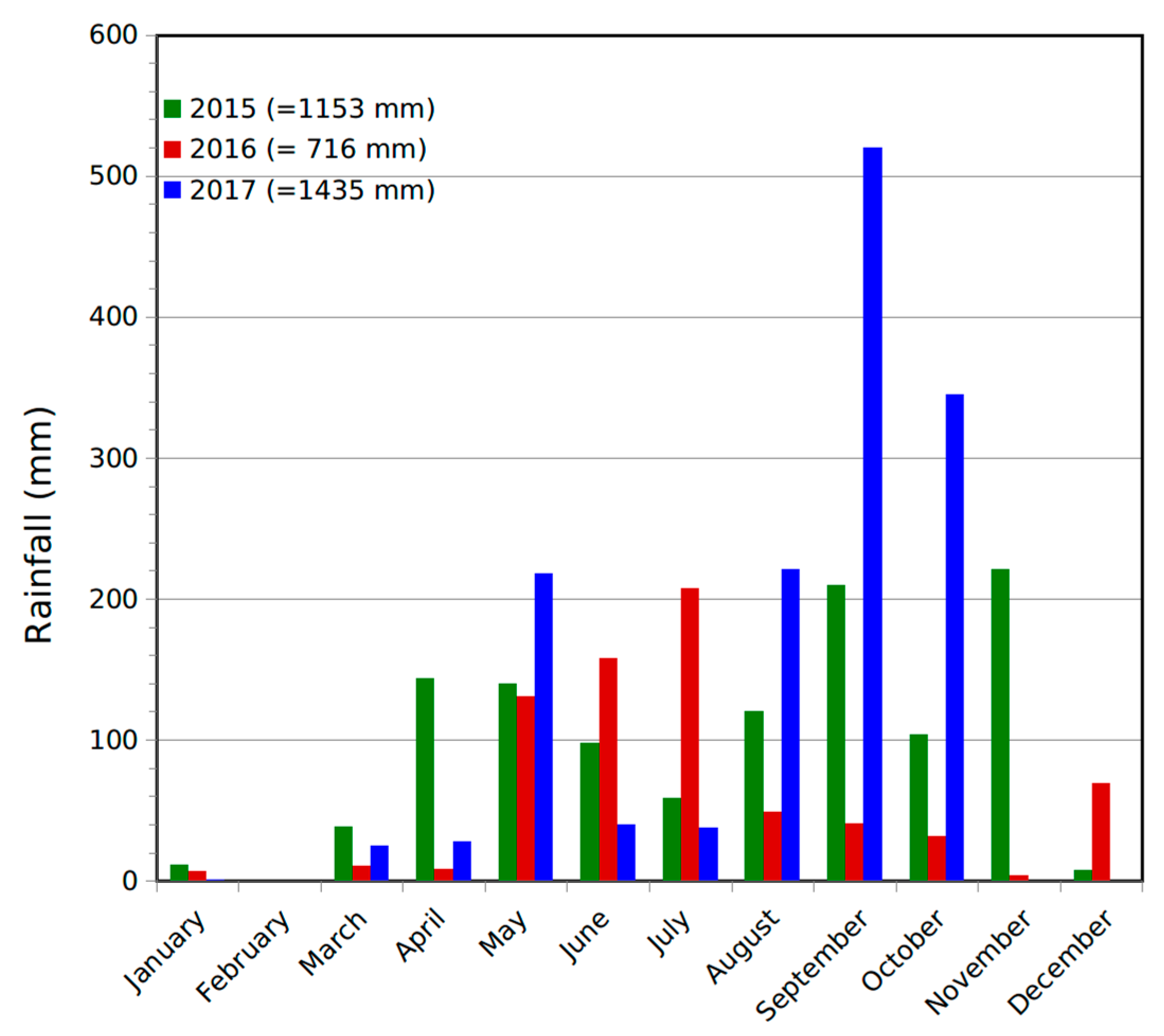




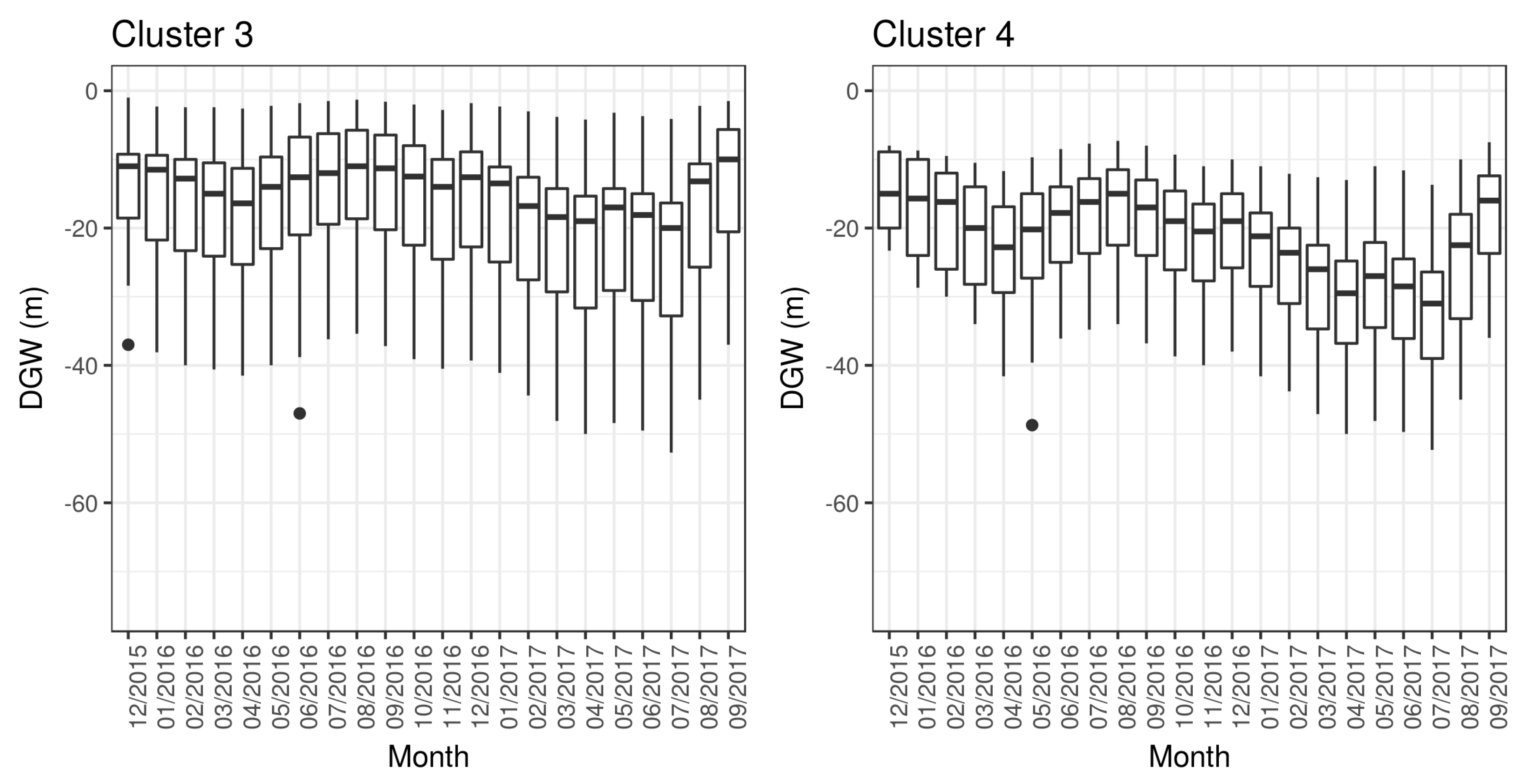
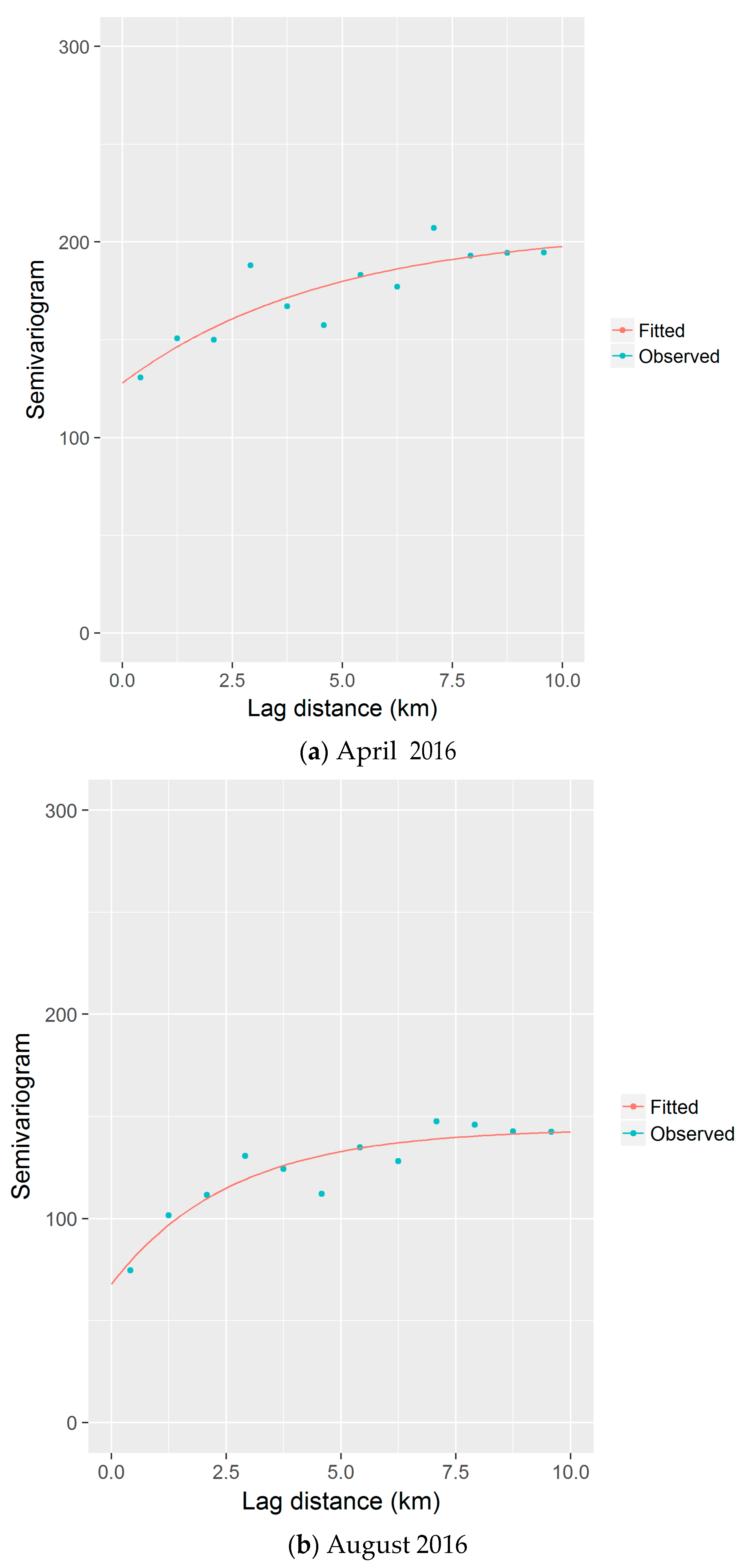




| Grid ID | Grid Name | Population | Percentage of Built-Up Area | Elevation (m) | Percentage of People Using Groundwater | Relative Density of Water Supply Pipeline |
|---|---|---|---|---|---|---|
| 1 | Ganganahalli | 76,442 | 15 | 901 | 15 | 0.000 |
| 2 | Vidyaranyapura | 143,937 | 28 | 907 | 28 | 0.063 |
| 3 | Yelahanka New Town | 222,281 | 35 | 905 | 35 | 0.088 |
| 4 | Agrahara | 117,935 | 28 | 919 | 28 | 0.016 |
| 5 | Peenya | 382,500 | 53 | 875 | 53 | 0.130 |
| 6 | Jalahalli | 363,359 | 67 | 914 | 67 | 0.892 |
| 7 | Hebbal | 506,535 | 71 | 892 | 71 | 0.565 |
| 8 | Hennur | 406,705 | 52 | 884 | 52 | 0.323 |
| 9 | Channasandra | 131,351 | 26 | 877 | 26 | 0.015 |
| 10 | Herohalli | 553,028 | 63 | 900 | 63 | 0.065 |
| 11 | Rajajinagar | 984,649 | 94 | 934 | 94 | 1.000 |
| 12 | Bangalore Palace | 525,245 | 89 | 937 | 89 | 0.643 |
| 13 | Cooke Town | 572,268 | 81 | 920 | 81 | 0.318 |
| 14 | Krishnarajapuram | 377,085 | 70 | 902 | 70 | 0.087 |
| 15 | Kodigehalli | 192,238 | 43 | 875 | 43 | 0.043 |
| 16 | Bangalore University | 332,918 | 38 | 851 | 38 | 0.008 |
| 17 | Chamarajpet | 1,048,839 | 92 | 849 | 92 | 0.608 |
| 18 | Shantinagar | 529,064 | 92 | 895 | 92 | 0.675 |
| 19 | Domlur | 395,813 | 69 | 905 | 69 | 0.488 |
| 20 | HAL Airport | 284,738 | 50 | 893 | 50 | 0.178 |
| 21 | Whitefield | 158,578 | 35 | 879 | 35 | 0.075 |
| 22 | Kengeri | 152,050 | 28 | 824 | 28 | 0.033 |
| 23 | Chikkasandra | 514,428 | 66 | 864 | 66 | 0.205 |
| 24 | JP Nagar | 691,729 | 87 | 906 | 87 | 0.146 |
| 25 | HSR Layout | 579,786 | 74 | 887 | 74 | 0.126 |
| 26 | Doddakannelli | 161,190 | 40 | 886 | 40 | 0.002 |
| 27 | Kothnur | 301,144 | 35 | 912 | 35 | 0.047 |
| 28 | Begur | 229,851 | 38 | 911 | 38 | 0.003 |
| Cluster ID | Grids | Description |
|---|---|---|
| 1 | 1, 2, 3, 4, 9, 15, 16, 21, 22, 26, 27 and 28 | Outer periphery, lower population density, significant open space, less water supply from BWSSB |
| 2 | 5, 8, 10, 14, 20, 23, 24 and 25 | Inner periphery, moderate population density, moderate open space, moderate water supply from BWSSB |
| 3 | 6, 7, 12, 13, 18 and 19 | Older city core, moderate population density, lower open space, better water supply from BWSSB |
| 4 | 11 and 17 | Highest population density, lower open space, better water supply from BWSSB |
| Cluster ID | Qnet (mm) | R (mm) | R − Qnet R (mm) |
|---|---|---|---|
| 1 | 128.89 (84.26) | 100.79 (69.22) | −28.10 |
| 2 | 138.33 (89.12) | 108.79 (73.05) | −29.54 |
| 3 | 86.00 (69.08) | 72.69 (59.89) | −13.31 |
| 4 | 118.85 (46.31) | 84.46 (34.78) | −34.39 |
© 2017 by the authors. Licensee MDPI, Basel, Switzerland. This article is an open access article distributed under the terms and conditions of the Creative Commons Attribution (CC BY) license (http://creativecommons.org/licenses/by/4.0/).
Share and Cite
Sekhar, M.; Tomer, S.K.; Thiyaku, S.; Giriraj, P.; Murthy, S.; Mehta, V.K. Groundwater Level Dynamics in Bengaluru City, India. Sustainability 2018, 10, 26. https://doi.org/10.3390/su10010026
Sekhar M, Tomer SK, Thiyaku S, Giriraj P, Murthy S, Mehta VK. Groundwater Level Dynamics in Bengaluru City, India. Sustainability. 2018; 10(1):26. https://doi.org/10.3390/su10010026
Chicago/Turabian StyleSekhar, M., Sat Kumar Tomer, S. Thiyaku, P. Giriraj, Sanjeeva Murthy, and Vishal K. Mehta. 2018. "Groundwater Level Dynamics in Bengaluru City, India" Sustainability 10, no. 1: 26. https://doi.org/10.3390/su10010026





